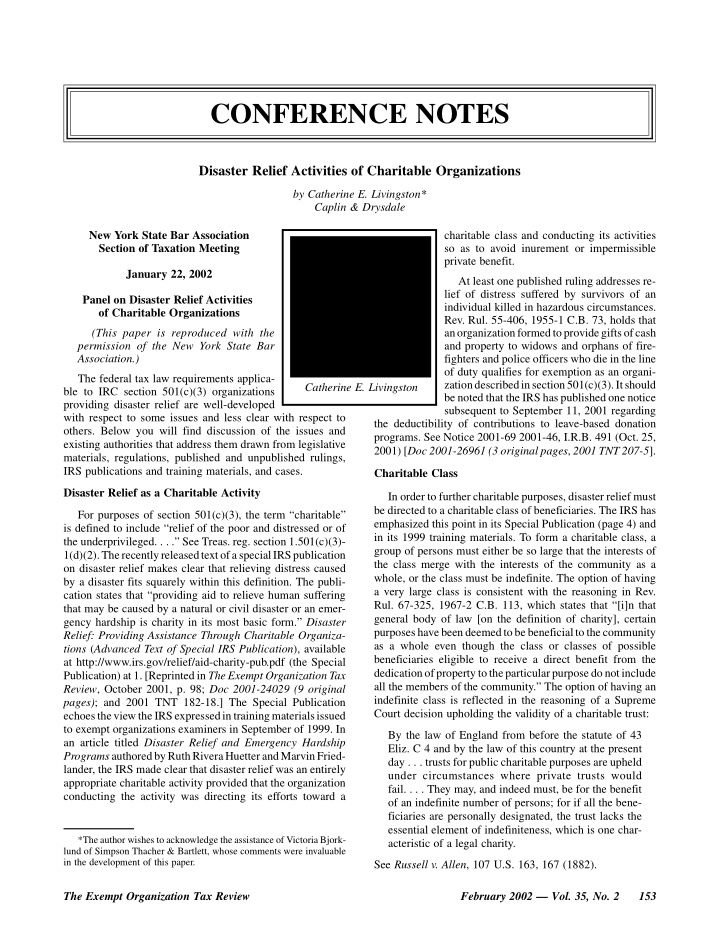



CONFERENCE NOTES Disaster Relief Activities of Charitable Organizations by Catherine E. Livingston* Caplin & Drysdale charitable class and conducting its activities New York State Bar Association so as to avoid inurement or impermissible Section of Taxation Meeting private benefit. January 22, 2002 At least one published ruling addresses re- lief of distress suffered by survivors of an Panel on Disaster Relief Activities individual killed in hazardous circumstances. of Charitable Organizations Rev. Rul. 55-406, 1955-1 C.B. 73, holds that an organization formed to provide gifts of cash (This paper is reproduced with the and property to widows and orphans of fire- permission of the New York State Bar fighters and police officers who die in the line Association.) of duty qualifies for exemption as an organi- The federal tax law requirements applica- zation describedin section 501(c)(3). Itshould Catherine E. Livingston ble to IRC section 501(c)(3) organizations be noted that the IRS has published one notice providing disaster relief are well-developed subsequent to September 11, 2001 regarding with respect to some issues and less clear with respect to the deductibility of contributions to leave-based donation others. Below you will find discussion of the issues and programs. See Notice 2001-69 2001-46, I.R.B. 491 (Oct. 25, existing authorities that address them drawn from legislative 2001) [ Doc 2001-26961 (3 original pages , 2001 TNT 207-5 ]. materials, regulations, published and unpublished rulings, IRS publications and training materials, and cases. Charitable Class Disaster Relief as a Charitable Activity In order to further charitable purposes, disaster relief must be directed to a charitable class of beneficiaries. The IRS has For purposes of section 501(c)(3), the term “charitable” emphasized this point in its Special Publication (page 4) and is defined to include “relief of the poor and distressed or of in its 1999 training materials. To form a charitable class, a the underprivileged. . . .” See Treas. reg. section 1.501(c)(3)- group of persons must either be so large that the interests of 1(d)(2). The recentlyreleased text of a specialIRS publication the class merge with the interests of the community as a on disaster relief makes clear that relieving distress caused whole, or the class must be indefinite. The option of having by a disaster fits squarely within this definition. The publi- a very large class is consistent with the reasoning in Rev. cation states that “providing aid to relieve human suffering Rul. 67-325, 1967-2 C.B. 113, which states that “[i]n that that may be caused by a natural or civil disaster or an emer- general body of law [on the definition of charity], certain gency hardship is charity in its most basic form.” Disaster purposes have been deemed to be beneficial to the community Relief: Providing Assistance Through Charitable Organiza- as a whole even though the class or classes of possible tions ( Advanced Text of Special IRS Publication ), available beneficiaries eligible to receive a direct benefit from the at http://www.irs.gov/relief/aid-charity-pub.pdf (the Special dedication of property to the particular purpose do not include Publication) at 1. [Reprinted in The Exempt Organization Tax all the members of the community.” The option of having an Review , October 2001, p. 98; Doc 2001-24029 (9 original indefinite class is reflected in the reasoning of a Supreme pages) ; and 2001 TNT 182-18.] The Special Publication Court decision upholding the validity of a charitable trust: echoes the view the IRS expressed in training materials issued to exempt organizations examiners in September of 1999. In By the law of England from before the statute of 43 an article titled Disaster Relief and Emergency Hardship Eliz. C 4 and by the law of this country at the present Programs authored by Ruth RiveraHuetter and Marvin Fried- day . . . trusts for public charitable purposes are upheld lander, the IRS made clear that disaster relief was an entirely under circumstances where private trusts would appropriate charitable activity provided that the organization fail. . . . They may, and indeed must, be for the benefit conducting the activity was directing its efforts toward a of an indefinite number of persons; for if all the bene- ficiaries are personally designated, the trust lacks the essential element of indefiniteness, which is one char- *The author wishes to acknowledge the assistance of Victoria Bjork- acteristic of a legal charity. lund of Simpson Thacher & Bartlett, whose comments were invaluable in the development of this paper. See Russell v. Allen , 107 U.S. 163, 167 (1882). The Exempt Organization Tax Review February 2002 — Vol. 35, No. 2 153
Recommend
More recommend